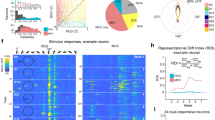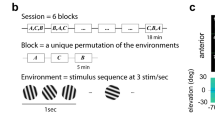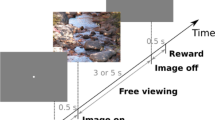Abstract
During vision, it is believed that neural activity in the primary visual cortex is predominantly driven by sensory input from the environment. However, visual cortical neurons respond to repeated presentations of the same stimulus with a high degree of variability1,2,3,4. Although this variability has been considered to be noise owing to random spontaneous activity within the cortex5,6,7, recent studies show that spontaneous activity has a highly coherent spatio-temporal structure8,9,10,11,12,13. This raises the possibility that the pattern of this spontaneous activity may shape neural responses during natural viewing conditions to a larger extent than previously thought. Here, we examine the relationship between spontaneous activity and the response of primary visual cortical neurons to dynamic natural-scene and random-noise film images in awake, freely viewing ferrets from the time of eye opening to maturity. The correspondence between evoked neural activity and the structure of the input signal was weak in young animals, but systematically improved with age. This improvement was linked to a shift in the dynamics of spontaneous activity. At all ages including the mature animal, correlations in spontaneous neural firing were only slightly modified by visual stimulation, irrespective of the sensory input. These results suggest that in both the developing and mature visual cortex, sensory evoked neural activity represents the modulation and triggering of ongoing circuit dynamics by input signals, rather than directly reflecting the structure of the input signal itself.
This is a preview of subscription content, access via your institution
Access options
Subscribe to this journal
Receive 51 print issues and online access
$199.00 per year
only $3.90 per issue
Buy this article
- Purchase on Springer Link
- Instant access to full article PDF
Prices may be subject to local taxes which are calculated during checkout




Similar content being viewed by others
References
Henry, G. H., Bishop, P. O., Tupper, R. M. & Dreher, B. Orientation specificity and response variability of cells in striate cortex. Vision Res. 13, 1771–1779 (1973)
Schiller, P. H., Finlay, B. L. & Volman, S. F. Short-term response variability of monkey striate neurons. Brain Res. 105, 347–349 (1976)
Vogels, R., Spileers, W. & Orban, G. A. The response variability of striate cortical neurons in the behaving monkey. Exp. Brain Res. 77, 432–436 (1989)
Azouz, R. & Gray, C. M. Cellular mechanisms contributing to response variability of cortical neurons in vivo. J. Neurosci. 19, 2209–2223 (1999)
Zohary, E., Shadlen, M. N. & Newsome, W. T. Correlated neuronal discharge rate and its implications for psychophysical performance. Nature 370, 140–143 (1994)
Shadlen, M. N. & Newsome, W. T. The variable discharge of cortical neurons: Implications for connectivity, computation, and information coding. J. Neurosci. 18, 3870–3896 (1998)
Pouget, A., Dayan, P. & Zemel, R. Inference and computation with population codes. Annu. Rev. Neurosci. 26, 381–410 (2004)
Meister, M., Wong, R. O. L., Baylor, D. A. & Shatz, C. J. Synchronous bursts of action potentials in ganglion cells of the developing mammalian retina. Science 252, 939–943 (1991)
Arieli, A., Shoham, D., Hildesheim, R. & Grinvald, A. Coherent spatiotemporal patterns of ongoing activity revealed by real-time optical imaging coupled with single-unit recording in the cat visual cortex. J. Neurophysiol. 73, 2072–2093 (1995)
Weliky, M. & Katz, L. C. Correlational structure of spontaneous neuronal activity in the developing lateral geniculate nucleus in vivo. Science 285, 599–604 (1999)
Tsodyks, M., Kenet, T., Grinvald, A. & Arieli, A. Linking spontaneous activity of single cortical neurons and the underlying functional architecture. Science 286, 1943–1946 (1999)
Chiu, C. & Weliky, M. Spontaneous activity in developing ferret visual cortex in vivo. J. Neurosci. 21, 8906–8914 (2001)
Kenet, T., Bibitchkov, D., Tsodyks, M., Grinvald, A. & Arieli, A. Spontaneously emerging cortical representations of visual attributes. Nature 425, 954–956 (2003)
Gao, W., Newman, D. E., Wormington, A. B. & Pallas, S. Development of inhibitory circuitry in visual and auditory cortex of postnatal ferrets: Immunocytochemical localization of GABAergic neurons. J. Comp. Neurol. 409, 261–273 (1999)
Anderson, J., Lampl, I., Reichova, I., Carandini, M. & Ferster, D. Stimulus dependence of two-state fluctuations of membrane potential in cat visual cortex. Nature Neurosci. 3, 617–621 (2000)
Cossart, R., Aronov, D. & Yuste, R. Attractor dynamics of network UP states in the neocortex. Nature 423, 283–288 (2003)
Shu, Y. S., Hasenstaub, A., Badoual, M., Bal, T. & McCormick, D. A. Barrages of synaptic activity control the gain and sensitivity of cortical neurons. J. Neurosci. 23, 10388–10401 (2003)
Gallant, J. L., Connor, C. E. & Van Essen, D. C. Neural activity in areas V1, V2 and V4 during free viewing of natural scenes compared to controlled viewing. Neuroreport 9, 1673–1678 (1998)
Vinje, W. E. & Gallant, J. L. Sparse coding and decorrelation in primary visual cortex during natural vision. Science 287, 1273–1276 (2000)
Gawne, T. J. & Richmond, B. J. How independent are the messages carried by adjacent inferior temporal cortical neurons? J. Neurosci. 13, 2758–2771 (1993)
Pola, G., Thiele, A., Hoffmann, K. P. & Panzeri, S. An exact method to quantify the information transmitted by different mechanisms of correlational coding. Network Comput. Neural Syst. 14, 35–60 (2003)
Nirenberg, S. & Latham, P. E. Decoding neuronal spike trains: How important are correlations? Proc Natl Acad. Sci. USA 100, 1045–1050 (2003)
Kara, P., Reinagel, P. & Reid, R. C. Low response variability in simultaneously recorded retinal, thalamic, and cortical neurons. Neuron 27, 635–646 (2000)
Hirsch, J. A. et al. Synaptic physiology of the flow of information in the cat's visual cortex in vivo. J. Physiol. (Lond.) 540, 335–350 (2002)
Attwell, D. & Laughlin, S. B. An energy budget for signaling in the grey matter of the brain. J. Cereb. Blood Flow Metab. 21, 1133–1145 (2001)
Lennie, P. The cost of cortical computation. Curr. Biol. 13, 493–497 (2003)
Weliky, M., Fiser, J., Hunt, R. H. & Wagner, D. N. Coding of natural scenes in primary visual cortex. Neuron 37, 703–718 (2003)
Acknowledgements
This work was supported by NIH (NEI) and the McKnight Foundation. We thank David Wagner for technical assistance. We also thank R. Aslin, D. Knill, D. Lee and K. Nordeen for comments. We also thank E. Romanski for supplying the ISCAN equipment.
Author information
Authors and Affiliations
Corresponding author
Ethics declarations
Competing interests
The authors declare that they have no competing financial interests.
Supplementary information
Supplementary Data
This file contains three sections. S1 offers a brief discussion of the individual pair-wise cross-correlation analysis. A figure and the corresponding figure legend are provided. In S2, details of eye-movement monitoring are supplied. We included a paragraph on methods, a figure and the figure legend. The final section, S3, contains a figure and its figure legend regarding the recordings under anaesthesia. Two references are provided at the end. (PDF 220 kb)
Rights and permissions
About this article
Cite this article
Fiser, J., Chiu, C. & Weliky, M. Small modulation of ongoing cortical dynamics by sensory input during natural vision. Nature 431, 573–578 (2004). https://doi.org/10.1038/nature02907
Received:
Accepted:
Issue Date:
DOI: https://doi.org/10.1038/nature02907
Comments
By submitting a comment you agree to abide by our Terms and Community Guidelines. If you find something abusive or that does not comply with our terms or guidelines please flag it as inappropriate.



